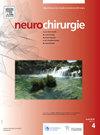嗅觉神经鞘瘤的起源:对附着部位变异性和临床意义的系统回顾和分析
IF 1.4
4区 医学
Q4 CLINICAL NEUROLOGY
引用次数: 0
摘要
嗅觉神经鞘瘤(OS)的附着部位包括嗅沟和筛状板、前颅底、大脑镰、鼻嵴、眼眶和蝶平面。本文献综述旨在描述与OS附着位点相关的结果。方法利用PubMed进行文献回顾。仅包括描述OS和肿瘤起源的研究。研究的主要结果是嗅觉丧失结果和肿瘤特征。结果共纳入38篇研究,42例OS。71.4% (n = 30)的骨肉瘤起源于嗅沟或筛板,其余28.6% (n = 12)的骨肉瘤附着于前窝的其他部位。59.5%的肿瘤侵蚀到筛骨,45.2%的肿瘤有囊性成分,42.9%的肿瘤被包裹,21.4%的肿瘤血管增生,21.4%的肿瘤伴有钙化。35.7%的病例出现硬脑膜附着。所有患者均报告主观症状改善,无显著发病率或死亡率。93.0%的病例全部切除。术后并发症发生率为11.9%。24.1%的患者有持续的嗅觉缺失,31.0%的患者有改善的嗅觉缺失。OS发生部位对嗅觉丧失或术后并发症的风险无影响。结论显微外科手术治疗骨性骨肉瘤临床效果好,切除率高,发病率和复发率低。与先前的断言相反,基于肿瘤附着部位的结果没有统计学上的显著差异。本文章由计算机程序翻译,如有差异,请以英文原文为准。
On the origin of olfactory schwannomas: A systematic review and analysis of attachment site variability and clinical implications
Background
Olfactory schwannomas (OS) attachment sites include the olfactory groove and cribriform plate, the anterior skull base, falx cerebri, crista galli, orbit and the planum sphenoidale. This literature review aims to characterize outcomes associated with OS attachment sites.
Methods
A literature review was conducted utilizing PubMed. Only studies describing OS and the tumor's origin were included. The primary outcomes of interest were anosmia outcomes and tumor characteristics.
Results
Thirty-eight studies including 42 cases of OS were included. 71.4% (n = 30) of OS originated from the olfactory groove or cribriform plate, while the remaining 28.6% (n = 12) had attachment sites elsewhere in the anterior fossa. 59.5% of cases eroded into the ethmoid bone, 45.2% of tumors had cystic components, 42.9% were encapsulated, 21.4% were hypervascular, and 21.4% had associated calcification. Dural attachment was described in 35.7% of cases. All patients reported subjective improvement in symptoms and there was no significant morbidity or mortality. Gross total resection was reported in 93.0% cases. Post-operative complications occurred in 11.9%. Persistent of anosmia was noted in 24.1% cases and improved anosmia was documented in 31.0% cases. OS site of origin had no impact on risk of anosmia or post-operative complications.
Conclusions
Microsurgical resection of OS is associated with excellent clinical outcomes, resection rates, and low morbidity and recurrence rates. Contrary to prior assertions, there was no statistically significant difference in outcomes based on tumor attachment site.
求助全文
通过发布文献求助,成功后即可免费获取论文全文。
去求助
来源期刊

Neurochirurgie
医学-临床神经学
CiteScore
2.70
自引率
6.20%
发文量
100
审稿时长
29 days
期刊介绍:
Neurochirurgie publishes articles on treatment, teaching and research, neurosurgery training and the professional aspects of our discipline, and also the history and progress of neurosurgery. It focuses on pathologies of the head, spine and central and peripheral nervous systems and their vascularization. All aspects of the specialty are dealt with: trauma, tumor, degenerative disease, infection, vascular pathology, and radiosurgery, and pediatrics. Transversal studies are also welcome: neuroanatomy, neurophysiology, neurology, neuropediatrics, psychiatry, neuropsychology, physical medicine and neurologic rehabilitation, neuro-anesthesia, neurologic intensive care, neuroradiology, functional exploration, neuropathology, neuro-ophthalmology, otoneurology, maxillofacial surgery, neuro-endocrinology and spine surgery. Technical and methodological aspects are also taken onboard: diagnostic and therapeutic techniques, methods for assessing results, epidemiology, surgical, interventional and radiological techniques, simulations and pathophysiological hypotheses, and educational tools. The editorial board may refuse submissions that fail to meet the journal''s aims and scope; such studies will not be peer-reviewed, and the editor in chief will promptly inform the corresponding author, so as not to delay submission to a more suitable journal.
With a view to attracting an international audience of both readers and writers, Neurochirurgie especially welcomes articles in English, and gives priority to original studies. Other kinds of article - reviews, case reports, technical notes and meta-analyses - are equally published.
Every year, a special edition is dedicated to the topic selected by the French Society of Neurosurgery for its annual report.
 求助内容:
求助内容: 应助结果提醒方式:
应助结果提醒方式:


